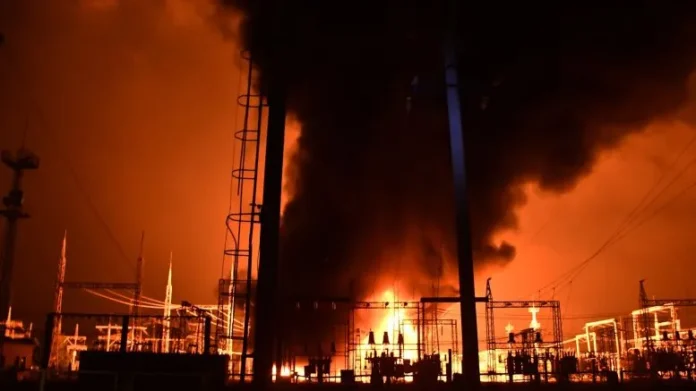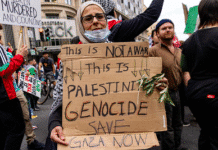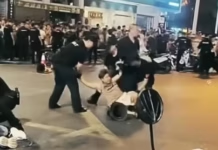The most likely perspective remains that the war will continue for a long time. Neither side has any interest in negotiations
Per-Ake Westerlund, Socialistiskt Alternativ (ISA in Sweden)
(This article was first published on 11 April 2023)
The expected Ukrainian spring offensive against Russian occupation forces is getting closer. Preparations have been underway since November. Since last autumn, tens of thousands of soldiers have died in World War I style fighting, especially around the city of Bakhmut.
Russian forces have captured parts of the city, at great cost, but otherwise have not advanced anywhere along the long frontline. The focus for Moscow has been state terrorist-style bombing, with missiles and shells against civilians and energy supplies. The latter has now largely stopped and Ukraine has even exported electricity in the last week.
Russian troops have also significantly strengthened their defences for the upcoming offensive, with long trenches, mines and prepared artillery. At the same time, Russian commanders reportedly ordered the evacuation of the civilian population in the regions of Kherson and Zaporizhia, which were annexed last autumn.
The planned Ukrainian offensive aims to regain territory, similar to the offensives around Kharkiv and the retaking of the city of Kherson last autumn. The Ukrainian government wants to show that the fighting has not reached an unbreakable stalemate and thus continue to secure support from the Western powers.
Morale under threat
The superior morale and motivation of the Ukrainian army compared to the Russian troops has had a major impact during the war. But more and more Ukrainian soldiers are exposed to widespread death and violence, which is affecting their morale, according to reports from The New York Times, which interviewed dozens of frontline soldiers. There are even reports of some desertion, especially around Bakhmut.
The Swedish daily paper, Dagens Nyheter on 11 April cited leaked Pentagon documents stating that Ukraine has “problems in accumulating soldiers, ammunition and equipment in sufficient quantity, and a counter-offensive may lead to only ‘moderate territorial successes’. The United States has held theory exercises with Ukrainian military leaders that concluded, according to the papers, that Ukraine is “beginning to understand the limitations of what can be achieved in a counteroffensive.”
Despite the large shipments of arms and ammunition from the West, there is a shortage especially of ammunition. Ukrainian forces fire 7,700 shells every day, one every six seconds, but have recently been forced to ration.
The US has a firm grip
The war means that US imperialism has established a firmer grip on the Western powers. “Over the past year, the United States has built a coalition of nations from the Atlantic to the Pacific,” Biden said during his visit to Ukraine. US Defence Secretary Lloyd Austin leads the so-called Contact Group, which consists of more than 50 governments.
Two tank battalions (160 tanks) from a number of countries are in place and another 4–5 battalions are expected soon. Requested artillery ammunition has been delivered on a large scale. So far, Ukraine has been denied US fighter jets, but work is underway to adapt new weapons to old fighter jets.
The Ukrainian army is more or less integrated into NATO and US military systems, but Zelensky and the Ukrainian leadership are demanding more weapons and support.
Spring offensive southwards
The spring offensive will not be a single wave of attacks. It has several options, which are now being considered in Kiev and Washington. Military experts believe that an attack southwards to take the city of Melitopol, about 80 kilometers from the front line, is the most likely. In that case, they would cut the Russian-controlled territory in two. An alternative, or possible complement, is an attack from the north towards Luhansk.
In October, an operation involving 600 soldiers on some 40 boats failed to retake the Zaporizhia nuclear power plant, emphasising that Ukraine needs materials for bridges and amphibious operations to cross the Dnieper and other rivers.
No real Russian advances
The Russian attacks that began in January have culminated, according to war analysts at the US-based ISW Institute.
During the winter, Russia fired three times more shells than Ukraine; artillery remains its main weapon. Ground troops have barely advanced at all, and fighter jets are firing missiles from afar to avoid anti-aircraft fire.
These weaknesses have increased criticism from warmongers within Russia. The notorious Igor Girkin has formed the “Angry Patriots Club”, which warns that Russia is heading for defeat. The aim is said to be to stop proposals for negotiations and to defend Russia against a Western coup. Yevgeny Prigozhin, the leader of the private army Wagner Group, has also formed a movement and started cooperating with the “Fair Russia — for the Truth” party.
They have gained new momentum after the bombing that killed far-right blogger Maxim Fomin (Tatarsky) in St. Petersburg. This act is also used by the regime to accuse anti-war protesters of “terrorism”. The Kremlin last week labelled feminism an “extremist ideology”, citing the fact that the accused bomber is a woman and a feminist.
NATO expansion
NATO’s border with Russia doubled with the accession of Finland last week. This is a major reinforcement as Finland’s military focus has always been on Russia. The country still has conscription, a large army (280,000 soldiers in a war situation) and claims to have “Western Europe’s strongest artillery” with 1,500 weapons. Sweden’s military is already adding even more to NATO’s strength.
In addition to the weapons provided and the training of 10,000 soldiers, US intelligence plays an important role in the war. Hundreds of recently leaked documents show how the US had prior knowledge of Russian rocket and missile attacks on Ukrainian military targets.
As of 24 February (according to the Kiel Institute’s count), the US had sent and promised €71.3 billion to Ukraine, of which €45.3 billion were weapons. For US imperialism, the war is about geopolitics, using military power to weaken Russia, and warn China.
Xi and Putin
Appeals from Macron or the EU for China to play a mediating role are nothing more than smokescreens and diplomatic waffle to stay on good terms with Beijing for economic reasons. Both Xi Jinping’s ‘peace plan’ and his visit to Moscow emphasised how the CCP dictatorship is on Putin’s side. The peace plan says nothing about the Russian invasion or Russian troops. In Moscow, Putin praised Xi’s “objective, impartial position” on the war.
At the same time, Xi Jinping avoided promises of financial and military aid, to avoid even worse sanctions already implemented by the US against China. In practice, there is economic support and dependence, with trade between the two countries reaching a record $190 billion in 2022. Putin also praised China’s economic model (of dictatorial state capitalism) as “much more efficient” than other countries.
Bakhmut and Crimea
In the coming weeks, reports will continue to focus on Bakhmut and increasingly on Crimea. Senior US generals and NATO leaders advocated a retreat from Bakhmut, while Zelensky instead emphasised the importance of holding the city. At the time of writing, Russian troops have taken the city centre, but Ukraine still holds its western part. There may be a retreat, but the Russian propaganda success will be short-lived.
Crimea is important as a base for the Russian military. Ukraine has increased its unofficial drone attacks on the peninsula, now with US backing. Kiev continues to emphasise the goal of taking back Crimea, but has also opened the possibility of negotiations if its military approaches. With Russian rule since 2014, it is far from clear that the current population of Crimea would automatically welcome Ukrainian rule.
A long war
The most likely perspective remains that the war will continue for a long time. Neither side has any interest in negotiations: Ukraine with the hope of future successes, while Putin cannot accept a total failure to achieve his goals. Major losses on both sides without decisive changes could possibly change this. In such a situation, Putin’s threats to use nuclear weapons and warnings of chaos in Russia could put pressure on Western powers to support negotiations. But these in turn, as in 2014, would not resolve differences and would instead start an escalation towards a new war.
The only force that can create lasting peace is the working class, in Russia, Ukraine and internationally. But there is still no independent organisation in the region that can provide an alternative to, and political struggle against, capitalism and war.
The demonstration in Berlin a month ago, against the war and against sending weapons, was a step in the right direction, despite its political weaknesses. ISA members in Germany reported that “the mass of participants were ‘ordinary’ people” who were worried about “a further escalation of the war”. At a certain stage, a new anti-war movement, against Russia’s war and NATO militarism, can develop. It needs to have a clear left and working-class profile, and a programme that opposes the capitalist system that creates injustice, war and disaster, while responding to the nationalism of the right with internationalism and solidarity.




